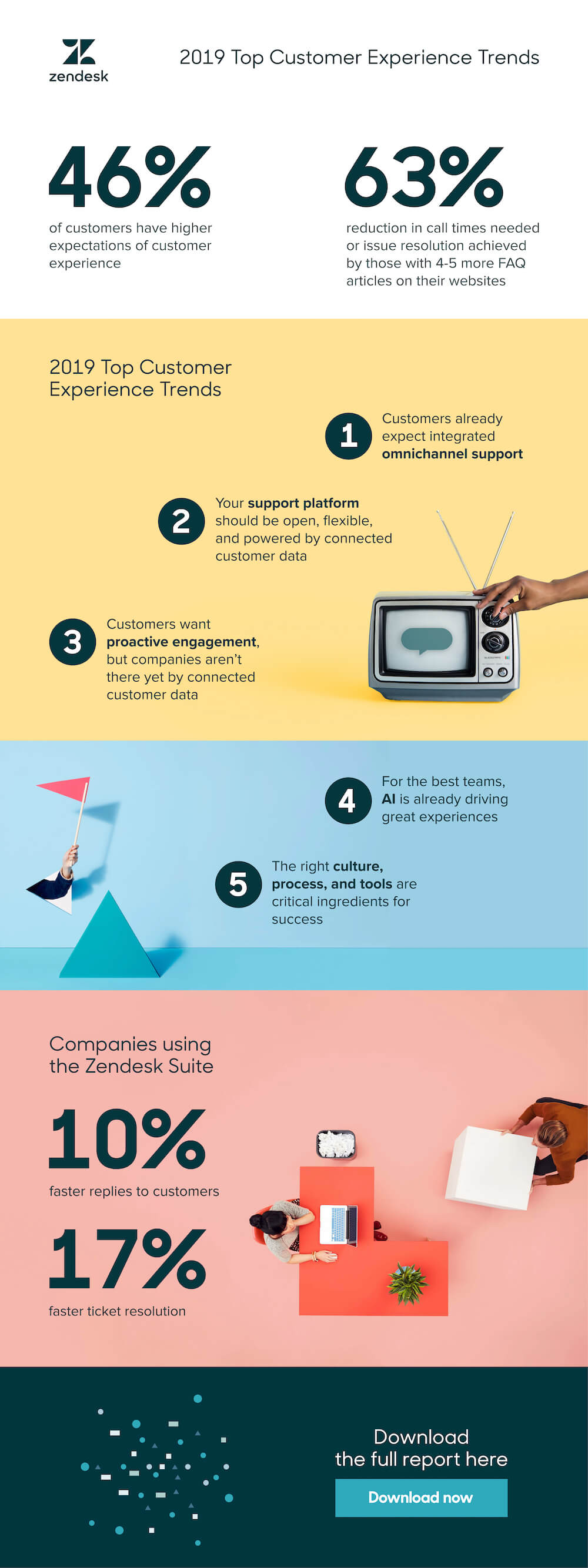
The five trends after deploying omnichannel; perfecting the customer experience

Seasoned professionals with a background in the provision of customer experience & support will indubitably be interested in the Zendesk Customer Experience Trends 2019 report, and its contents should provide an impetus for customer-facing departments to improve their practices. What’s perhaps more surprising than some of the report’s findings (see below) is that making significant changes in policy and practice in many customer experience functions is more complex and challenging to implement.
That’s always been the case with any incisive document on an industry segment that’s as quickly-changing as customer expectations. But the Zendesk survey is accompanied by a ‘how-to’ guide that takes many of the report’s findings and provides ways that the results can be actioned. Both documents are a matter of public record and contain all the necessary details for a proactive change approach to be taken to revitalizing customer care (and thereby boosting customer satisfaction and staff happiness metrics).
But, as you might expect, the detailed findings take some reading, so here at Tech Wire Asia, we thought we’d provide our readers with a shortened, yet (we hope) interesting and illuminating summary.
Omnichannel is king
As this essay discusses, what customer experience (CX) professionals call omnichannel is just normality for today’s consumers, armed as they are with smartphones, tablets or laptops. In short, an omnichannel support platform is the mandatory bedrock of 21st-century customer care.
Because individuals move seamlessly from voice call to text to social media DM, to email and back to voice call, all without losing their thread, so too must the companies they contact. Repeating to a representative on the phone what was previously expressed in an email is frustrating both for customer and staff, and frankly, it’s just not acceptable in today’s interconnected age.
Different demographic segments prefer different communication methods, and some queries are best answered by an automated bot, or addressed by webpage FAQ, for instance. What’s important is the effectiveness and intelligence of any response. In short, customers want the best outcome: it’s a results-based equation, irrespective of the channel (or channels).
People love self-service, sometimes
Millennials and Generation Z-ers, the report found, prefer to root out their own answers much more than older generations. And in some instances, simply pushing people to an FAQ list is absolutely the right thing. The next generation of the FAQ is the intelligent bot, be that a text bot, or an automated voice response system. Regardless of the method, the report found that the best performing help centers have 4.5 times more articles available than their less successful counterparts.
And there’s nothing worse than a stale help article. Out of date information breaks the first rule of customer care in this context; that of the provision of useful results, quickly. References to older systems and practices that don’t work any longer drive customers mad, and the figures for customer satisfaction levels will reflect that. Additionally, the better customers can help themselves, the fewer the number of ‘live’ tickets; ticket re-opens were 20 percent down at organizations with extensive and up-to-date self-help systems.
It’s (a)live!
Integrating voice and chat means that initial time-to-response rates get slashed. The phone is still the most popular channel to contact the customer care facilities of companies, the report found, with 68 percent preferring the channel. But beware, as merely providing a phone line simply isn’t enough. Forty-one percent of people thought that having to repeat oneself during interactions was the most important factor that contributed to dissatisfaction.
In short, when your agents pick up the phone, they need to be working from a platform that integrates phone and all other messaging channels, in one place – in today’s terminology, that’s a single pane of glass. Again, the statistic circles back to the single issue of customers needing an expeditious interaction with the company: they have a goal in mind and expect the aim fulfilled as quickly as possible.
Prioritize to change expectations
Customer support departments with a response time of less than eight hours from a web-based widget submission (or less than 4.5 hours from a ‘traditional’ web form) performed better than their slower counterparts. Similarly, if you can respond to emails in under a half day, not in around 12 hours, you’ll be emulating the best in class.

Standard support channels like email and web forms see much longer reply and resolution times, the report found. Therefore, if you want to make a difference, prioritizing resources to those channels seems like a good idea.
The caveat is, of course, that automated systems that don’t use cutting-edge AI (artificial intelligence) find it challenging to deploy any form of automation in these written, or text-based channels, as the reliance on clever natural language processing is beyond most platforms. Therefore, unless companies use the very latest in technology, they need to deploy staff to address the issues expressed in these channels: sentiments & issues are often more complex and involved, so ensuring that your most-trained, most experienced staff are on hand is vitally important.
Right channel, right time
Not many companies have the luxury of a single customer type in today’s market. Kids’ clothes are bought by grandparents and parents-to-be alike, and no single demographic buys technology and services; in short, there’s no single customer type, so there’s no predicting favored communications methods. Therefore, your customer care platform needs to be all-encompassing, with a single set of policies with regards to response times and ticket clear-up rates applicable to any channel.
Creating a single source of truth is the task achieved by the very latest in customer care platforms; they provide the story behind each and every interaction, and let every single customer know that they’re an individual (in the parlance of customer care professionals, that’s “a personalized service at scale”).
The Zendesk report showed that the best customer experience teams set measurable targets and help each other in attaining those goals. Of course, that’s difficult to do if valuable time and resources are wasted switching from platform A to platform B, retrieving customer details from silo-ed databases and writing apologetic messages to disappointed customers.
Download & more information
See how your team stacks up against the rest with the Customer Support Performance Scorecard. Fill in your details to get a personalized score card and get the report on how to make the most of the biggest trends in customer support by clicking the link here. To read the Zendesk report in full, you can download it as a PDF from here and its accompanying how-to guide from here. And to get the lowdown on the absolute latest in omnichannel customer care management technology, talk to Zendesk. It’s the one company that provides a personalized, omnichannel platform which can make every customer into a brand ambassador.
READ MORE
- Ethical AI: The renewed importance of safeguarding data and customer privacy in Generative AI applications
- How Japan balances AI-driven opportunities with cybersecurity needs
- Deploying SASE: Benchmarking your approach
- Insurance everywhere all at once: the digital transformation of the APAC insurance industry
- Google parent Alphabet eyes HubSpot: A potential acquisition shaping the future of CRM

